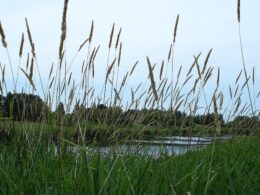Kikuyu Grass: Appearance
Kikuyu grass (Pennisetum clandestinum), also known as Kikuyugrass, is a fast-growing, warm-season turfgrass originally found in the savannas of East Africa. Kikuyu grass is a perennial, coarse-bladed turfgrass that grows in clumps and spreads aggressively by stolons, or rhizomes. Kikuyu grass grows 3 to 6 inches tall at maturity. It has a medium green color with thin, smooth blades that are flat or folded upward. The leaf color ranges from bright green to blue-green depending on growing conditions, fertilization and watering schedule.
Kikuyu Grass Habitat and Distribution
Kikuyu grass is a natural lawn grass in Kenya (after which it was named), Zimbabwe, Australia and South Africa. It has been widely introduced around the world for use as a fast-growing ground cover or turfgrass for active areas. It can be invasive, however, and requires regular mowing to keep it from taking over an area.
Kikuyu Grass Care
Kikuyu grass is a hardy, fast-growing species. It’s known for its excellent wear tolerance and good recovery rate, as well as its ability to withstand high foot traffic. This makes it a popular choice for sport fields and other commercial lawns. But is this grass easy to maintain? In general, Kikuyu is considered one of the lower maintenance lawn types. Here are some Kikuyu grass care tips.
Mowing
Kikuyu Grass care is crucial for keeping it looking its best. When you mow Kikuyu, it should be cut to a height of around 1.5 inches. It’s best to mow often enough that the grass doesn’t overgrow and give itself an opportunity to get sick or die from drought stress.
Watering
Kikuyu is tolerant of both drought and wet conditions (within reason), so watering is not as crucial as it might be with other types of grass. It’s a good idea to water new seedlings regularly until they take root, though – about once a week should do the trick. Watering twice a week is recommended if your soil drains poorly or if the weather is hot and windy. If you live in an area that gets lots of rain during summer months, you may not need to water at all during this time of year.
Soil
Kikuyu grass varieties prefer well-drained soils with a slightly acidic pH (between 5.5 and 7.0). If your soil is not already in this range, apply fertilizer to bring the pH into the desired range. Soil should be moist, but not wet or overly dry for Kikuyu grass growth.
Temperature
The best temperatures for Kikuyu grass growth are from 65 to 90 degrees Fahrenheit (18-32 C). When the weather gets hotter than this, it will still grow, but will turn yellow with dormancy. With too much shade, you might find that your Kikuyu grass starts to thin out, leaving large brown patches.
Kikuyu Propagation
One of the best methods for Kikuyu Grass propagation is through cuttings. The cutting process is one way to create a new lawn quickly. You can choose either a soft tip or hard base cutting, depending on the time of the year you want to plant. Alternatively, Kikuyu Grass can also be propagated through transplanting existing grass plugs onto your new turf area. This method works well when used alongside seeding, as it speeds up the germination process.
Kikuyu Grass as Weed
Kikuyu Grass is a perennial grass and is the most vigorous of all warm season grasses. Kikuyu is also one of the most widely used turf varieties of South Africa, where it can handle high temperatures and dry conditions while staying green year-round. But this tolerance comes at a cost: Kikuyu is extremely invasive, spreading rapidly by rhizomes (underground runners) and stolons (above ground runners). It can even establish itself from tiny pieces of rhizome or stolon only an inch long, as well as from cuttings of the leaf blades that are only two inches long.
Kikuyu Weed Control
You may have noticed that Kikuyu grass can become quite thick and dense in areas of your lawn during the warm months. If you leave it too long, Kikuyu grass will creep into your garden beds and over your paths, where it’s very difficult to remove. Difficult to control, Kikuyu grass can be killed and prevented in your lawn with the use of herbicides. The most effective way to control Kikuyu grass is to spray it with Roundup or any other glyphosate product as per the manufacturer’s instructions.
Kikuyu Use
However, on the flip side, Kikuyu can be useful as a lawn or pasture grass – it’s great for erosion control, and it tolerates heat and drought better than most other options. It can grow just about anywhere, including in both sandy and clay soils. Since it is drought-resistant, it is used as golf courses in California.



















